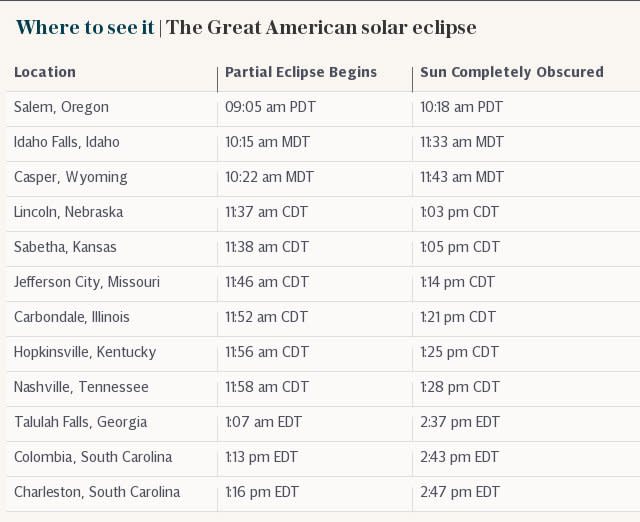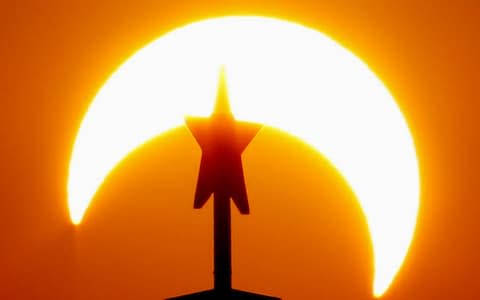Great American Eclipse: What is an eclipse, how can you watch it and where will it take place?

On Monday, August 21 the sun, moon and Earth will line up in an act of cosmic serendipity that will turn day into night across the 2,680-mile width of the United States.
It will be the first time that has happened in nearly a century, and never will a total solar eclipse be so heavily viewed and studied.
From Oregon in the west, to South Carolina in the east, there will be festivals and flamboyant eclipse viewing parties. And of course, traffic gridlock, an social media explosion, and general chaos
As one astronomer put it: "This will be the most photographed, most shared, most tweeted event in human history."
How unusual an event is this?
Full solar eclipses, when the moon positions itself smack between the sun and the Earth, happen every few years but often in remote areas or over the ocean.
This will be the first total solar eclipse in 99 years to cross the US coast-to-coast, and the first to pass through any part of the lower 48 states in 38 years.

Where is it happening?
The path of totality - where the light of the sun is completely blocked out by the moon - is 70 miles wide and stretches from Lincoln City, Oregon, to Charleston, South Carolina, passing through 14 states and 21 National Parks
The total eclipse will last about 90 minutes as the lunar shadow sweeps across America at more than 1,500 mph beginning about 10.15 am west coast time. On the east coast it will end at 2.49 pm east coast time.

Eclipse Fests, StarFests, SolarFests, SolFests, Darkening of the SunFests, MoonshadowFests, EclipseCons, Eclipse Encounters and Star Parties are planned along the path of totality.
Vineyards, breweries, museums, parks, universities, stadiums, just about everybody is getting into the act.

What if you're not in the US?
Don't worry, Nasa will be broadcasting the whole thing on the internet and TV.
Astronauts aboard the International Space Station will beam back pictures, as will ships and planes and high altitude balloons.
"This is a really amazing chance to just open the public's eyes to wonder," said physicist Angela Des Jardins, who is in charge of Nasa' eclipse video ballooning project.
Eclipses mean chaos
Will there be chaos? Undoubtedly. An estimated 200 million people live within a day's drive of the path of totality and huge crowds are expected.
The lightly populated state of Oregon is expecting up to one million eclipse chasers and is treating the event as an emergency. Police everywhere are asking people to be patient. Even stuck in a traffic jam the sight should be wonderful.

Rain means pain...
We won't know weather conditions until closer to the time - but above all, eclipse viewing is dependent on clear skies, and the best advice is to find somewhere high and dry.
Experienced eclipse watchers say the best bet is to avoid both coasts, where rain is more likely.
States like Wyoming and Idaho could fare better. Ideally, the best option is to be somewhere remote with access to a fast car and clear roads in case a cloud settles overhead.
The Astronomical League for amateur astronomers, who know a thing or two, are heading for Casper, Wyoming.
How long will totality last?
It varies in different places, Darkness will last just under two minutes in Oregon, gradually expanding to a maximum two minutes and 44 seconds in the Shawnee National Forest in southern Illinois, and into Kentucky, then dwindling to two-and-a-half minutes in South Carolina.
Will there also be a partial eclipse?
The partial eclipse will extend up through Canada and down through Central America and the top of South America.
Minneapolis will see 86 per cent of the sun covered, Miami 82 per cent, Montreal 66 per cent, and Mexico City sees 38 per cent.
Are protective eclipse glasses necessary?
Absolutely. The only time you can look at the eclipse is during totality.
Experts say at any point when the eclipse is partial, even if only a sliver of the sun is visible, it would burn the back of your eyes to look at it.
"Unfortunately, I think it is probably true that during every solar eclipse, there's bound to be somebody who does get hurt," said Ralph Chou, an optometry professor and leading authority on eye damage from eclipse viewing.

How about watching from a plane
South West Airlines has worked out that the eclipse will be visible from a handful of its scheduled flights, taking off from dEnver, Seattle and Portland.
They'll be serving "cosmic cocktails" to the lucky passengers.
Is there a Trump link to the eclipse?
The Boston Globe newspaper made a valiant attempt to link the eclipse to Donald Trump, noting that 92 per cent of the 240 counties in the path of totality voted for the president in last year's election.
However, the internet appeared to decide that this was a Trump link too far.
Leave it to the Globe to make a solar eclipse political.
(BTW Globe, the sun and moon don't care who's president!)— Gary Black (@GaryBlackal) August 4, 2017
ignoring politics for a sec and focusing only on eclipse mechanics.....isn't it trump supporters who get the shadehttps://t.co/uEbdxs1RbV
— Sarah Holder (@ptsarahdactyl) August 6, 2017
What do the experts say about eclipses?
Nasa guru Bill Cooke says: "It is the most weird, creepy, awe-inspiring astronomical event you will experience."
Rick Fienberg, spokesman for the American Astronomical Society: "Going through life without ever experiencing totality is like going through life without ever falling in love."
When's the next one in the US?
April 8, 2024. It might be even better with four minutes totality.

 Yahoo News
Yahoo News 
